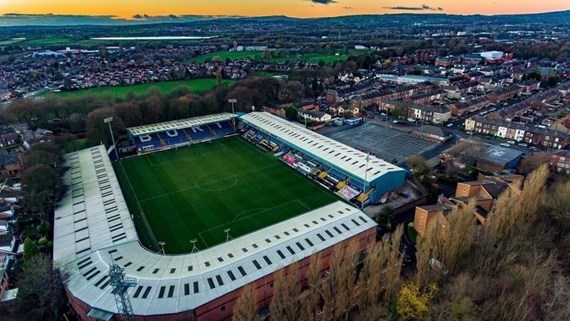Inn the Field of Play - November 2019: Bury Beware
Insight

“Caveat emptor” seems rather paradoxical when observing the plight of Bury F.C.
The story so far
In August Bury F.C. became the first club since Maidstone United in 1992 to be expelled from the English Football League. The 125-year old club was facing severe financial difficulties as far back as 2013, when it was bought by Stewart Day and saved from bankruptcy. Its debts were mounting in late 2018 when Day sold the club to Steve Dale for £1.
The club then faced a winding-up petition, adjourned three times, which was dismissed by the High Court in July 2019. Bury’s creditors then approved a company voluntary agreement (CVA) that intended to settle some of their debts but left “non-football” creditors (including HMRC) only 25 per cent of what they were owed. In EFL rules a CVA is a qualifying insolvency event; the league accordingly imposed a 12-point penalty on Bury and cancelled six fixtures.
On 8 August the EFL gave Bury a 14-day “do or die” deadline to come up with a plan to repay outstanding creditors or be expelled. Despite initially failing to do so, and after Manchester Mayor Andy Burnham and Bury North MP James Frith implored the league for an extension, Dale brokered a deal with C&N Sporting Risk for the sale of the club. This deal, nonetheless, collapsed.
The EFL expelled Bury F.C. from the league on 27 August 2019. HMRC has since brought a winding-up petition against the club on 16 October that has been adjourned for two weeks, allowing Bury breathing space to settle with small business creditors. The EFL rejected a proposal for Bury to re-enter League Two in the 2020-21 season.
What went wrong?
Commentators are currently divided as to what or indeed who was at fault but evidently a range of factors played their part. The more obvious drivers of Bury’s decline include poor governance by both the owners and regulators, although it is important to note the vast financial inequalities in the landscape that is English football. In the 2017-18 season the 20 Premier League clubs made combined operating profits before transfers of £900m. This stands in stark contrast to the 72 clubs in the Championship and Leagues One and Two which sustained combined losses of £411m. Loss-making lower league clubs, such as Bury F.C., face an inherent financial disadvantage.
Despite this palpably unequal playing field, it is worth reiterating that Bury is the first club to be expelled from the league for 27 years; the unstable financial state of the lower leagues is not exclusive to Bury and ultimately not the root cause of its fall. We must therefore focus on the specific issues that plagued Bury and led to its demise.
Irresponsible ownership
There are strong arguments to support the notion that Bury was driven to expulsion due to the actions of its owners. In pursuit of promotion Bury’s penultimate owner, the aforementioned Stewart Day, purchased players through loaning money to the club from his property businesses, then converted the cash to shares. When these businesses became insolvent, Bury instantly could not afford to pay its players and staff.
In a move thought of as unthinkable by many, Day also mortgaged Gigg Lane itself and the lender is now owed £3.7m. This loan allegedly accrues interest at almost £1,500 per day – a heavy loss for a debt-ridden club and a critical sticking point for C&N during the takeover talks.
Of the many businesses that Bury’s final owner has been associated with, a significant proportion have been liquidated or struck off by the registrar of companies. Steve Dale, who previously confessed to the BBC that he “didn’t even know there was a football team called Bury”, bought the club for £1, insisting that he had proved to the EFL that he had sufficient funds to start the season. Within months Dale had helped to facilitate a heavily criticised insolvency process and had called on the fans to “chip in” to save the club. The EFL did not enforce its rule that states that owners must prove they have the money to sustain their clubs.
It is clear that a portion of the blame lies with these two owners of the club. The last two owners of the club appear to have demonstrated a clear lack of responsibility and have exposed the fallibility of the existing rules. Yet their ability to do so indicates a flawed system; cracks in the EFL governance that need to be reinforced or reformed.
Owners’ responses
Stewart Day has largely remained quiet in the face of the media criticism, describing the last few months as a “nightmare” and claiming that he never wanted “to rip anyone off”. Steve Dale, by contrast, released a statement following Bury’s expulsion from the league that lashed out at the actions of the EFL. In this statement Dale apologised for the failure of his efforts to save the club and heavily criticised the EFL Executive Chair Debbie Jevans and the league for having an ulterior agenda and for causing Bury’s “devastation”.
Governance – need for an overhaul?
The EFL has come under sustained criticism by individuals and bodies ranging from the Bury MP James Frith to the potential rescuer of Bury F.C., C&N Sporting Risk. The main governance issues can be narrowed down to the following:
- Enforcement of rules;
- Lack of independent regulation; and
- Punishing the club, not the owners.
The EFL’s first failing was to allow Steve Dale to become owner with such limited evidence he could save the club. Former manager Neil Warnock described this decision as “criminal” and accused the EFL of not carrying out the necessary due diligence, in other words not knowing the extent of Bury’s debts. Under the rules new owners are supposed to demonstrate “proof of funding”, yet there is no punishment for one who does not. It is the club, not the owner, who is sanctioned.
Furthermore, the EFL rules are supposed to restrict clubs’ spending to within their means. As mentioned earlier Stewart Day was able to circumvent this by investing the extra capital into shares instead of taking loans. The result was that Bury could not afford to repay its debts nor pay its players and staff.
Finally, the EFL’s response to C&N’s request for an extension to complete due diligence and finish the deal was to give the company one working day. The process usually takes weeks.
The EFL has since committed to upgrade its regulations to ensure Bury’s fate is never repeated. Key questions arising are:
- Is this an admission of failure?
- Will the reforms go far enough?
The EFL has commissioned an independent review into the rules and measures regarding the financial sustainability of its clubs which is a step in the right direction. It is, however, worth noting that the Football Leagues have maintained that their rules are robust and do not require independent regulation; perhaps Bury’s example is proof of the opposite.
Lastly, the EFL’s decisions to penalise Bury F.C. by suspending games, deducting points and ultimate expulsion do not address the root problems. The sanctions impact the players, staff and fans but do not target the perpetrators of the club’s problems: the owners, who have come away largely unscathed.
MP select committee – key findings
The club’s demise has prompted an MP select committee hearing, in which Conservative MP Damian Collins damningly described the flaws in the EFL’s regulations as being “systematic and structural” but “avoidable”. The committee concluded that an “overhaul” was necessary, with key findings including:
- A demand that the EFL compensate Bury F.C. for its loss of earnings due to its expulsion from the league;
- A request for government intervention if satisfactory reforms are not made;
- An updated owners’ and directors’ test that would exclude buyers with unsatisfactory insolvency track records;
- The creation of a supporters’ ombudsman to deal with governance concerns;
- A ban on clubs borrowing against fixed assets (such as Gigg Lane stadium); and
- A recommendation that the EFL apologise to Bury staff and fans for its failings.
Conclusion
At the heart of the tragic events at Bury lies a fundamental lack of good governance. It is the system in place that allowed both Dale and Day to act the way they did; the inadequate regulation enabled the irresponsible ownership. Tighter regulation would surely protect clubs and communities from similar scenarios.
What next for Bury F.C.?
1. Re-entry to a lower league as a “phoenix club”
This is perfectly possible and has been demonstrated by Aldershot and Maidstone, both of whom were expelled by the EFL and then started again. Relegation by several tiers is typical which would mean that Bury could play next season in the Northern Premier League's North West Division.
2. The players
Many players have already left and those who remain are free agents due to their contracts being invalidated. In addition, their wages have not been paid since March.
3. The stadium
Gigg Lane would usually be the Bury F.C.’s most valuable asset but there is a £3.7m mortgage that drove potential rescuers away. If the phoenix club cannot use the stadium, they will have to find a smaller and cheaper ground.
4. Reinstatement?
The EFL have been clear in stating that their decision is conclusive and is not subject to an appeals procedure – they will, however, face continued pressure from MPs and fans which could change this.
We regularly advise on compliance issues related to the Code for Sports Governance and led by Tom Bruce, who is a “go-to” adviser on sports governance matters, we won Sports Governance Firm of the Year – UK in 2018.
If you require further information about anything covered in this briefing, please contact Tom Bruce, Jack Verdan or your usual contact at the firm on +44 (0)20 3375 7000.
This publication is a general summary of the law. It should not replace legal advice tailored to your specific circumstances.
© Farrer & Co LLP, October 2019







